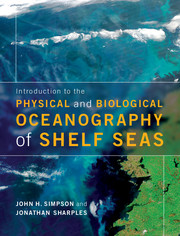Book contents
- Frontmatter
- Contents
- Preface
- Acknowledgements
- Guide to the book and how to make the best use of it
- Symbols
- 1 Introduction to the shelf seas
- 2 Physical forcing of the shelf seas: what drives the motion of ocean?
- 3 Response to forcing: the governing equations and some basic solutions
- 4 Waves, turbulent motions and mixing
- 5 Life in the shelf seas
- 6 Seasonal stratification and the spring bloom
- 7 Interior mixing and phytoplankton survival in stratified environments
- 8 Tidal mixing fronts: their location, dynamics and biological significance
- 9 Regions of freshwater influence (ROFIs)
- 10 The shelf edge system
- 11 Future challenges in shelf seas
- Glossary
- Answers to chapter problems
- References
- Index
- Plate section
6 - Seasonal stratification and the spring bloom
Published online by Cambridge University Press: 05 June 2012
- Frontmatter
- Contents
- Preface
- Acknowledgements
- Guide to the book and how to make the best use of it
- Symbols
- 1 Introduction to the shelf seas
- 2 Physical forcing of the shelf seas: what drives the motion of ocean?
- 3 Response to forcing: the governing equations and some basic solutions
- 4 Waves, turbulent motions and mixing
- 5 Life in the shelf seas
- 6 Seasonal stratification and the spring bloom
- 7 Interior mixing and phytoplankton survival in stratified environments
- 8 Tidal mixing fronts: their location, dynamics and biological significance
- 9 Regions of freshwater influence (ROFIs)
- 10 The shelf edge system
- 11 Future challenges in shelf seas
- Glossary
- Answers to chapter problems
- References
- Index
- Plate section
Summary
We have now provided the foundations in physics and biology that can be used to understand how shelf sea ecosystems are driven by the underlying physics. In this chapter we will begin our journey through the links between physics and biology in shelf seas by identifying the role of physics in partitioning the shelf seas into biogeochemically contrasting regimes. Recall from Chapter 5 that the vertical structure of the water column is critical in determining the availability of both light and nutrients to phytoplankton. In this chapter we first consider the fundamental physical controls that determine whether or not a region will thermally stratify in spring. We derive a condition for seasonal stratification to occur which indicates that, during the summer season, the shelf seas will be divided into stratified and mixed regimes. We then consider the spring stratification as the physical trigger for the spring bloom of phytoplankton. This highlights the spatial partitioning into mixed and stratifying regions as controlling whether or not regions experience a spring bloom.
Buoyancy inputs versus vertical mixing: the heating-stirring competition
The vertical structure of the water column is the result of an ongoing competition between the buoyancy inputs, due to surface heating and freshwater input on the one hand and stirring by the tides and wind stress on the other. Our focus here is on temperate shelf sea regions where the dominant buoyancy input is a seasonally varying surface heat flux. We will deal with freshwater as a source of buoyancy in Chapter 9. During the winter months, when heat is lost from the surface, the buoyancy term contributes to stirring by increasing surface density and making all or part of the water column convectively unstable. As a result, apart from limited areas influenced by large positive buoyancy inputs from estuaries, the shelf seas are vertically well mixed during the winter months. This vertically mixed regime continues until the onset of positive heating at, or close to, the vernal equinox (21 March/September in the northern/southern hemisphere) after which the increasing input of positive buoyancy tends to stabilize the water column. Whether or not the water column stratifies is then dependent on the relative strengths of the surface heating and the stirring due to frictional stresses imposed at the bottom boundary by the tidal flow and at the surface by wind stress.
- Type
- Chapter
- Information
- Publisher: Cambridge University PressPrint publication year: 2012
- 1
- Cited by



